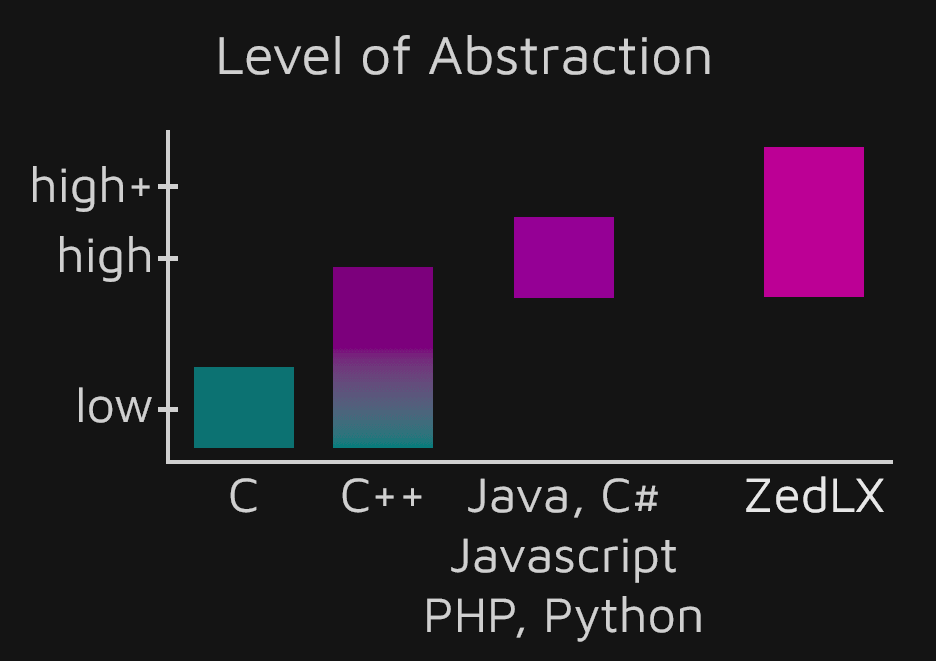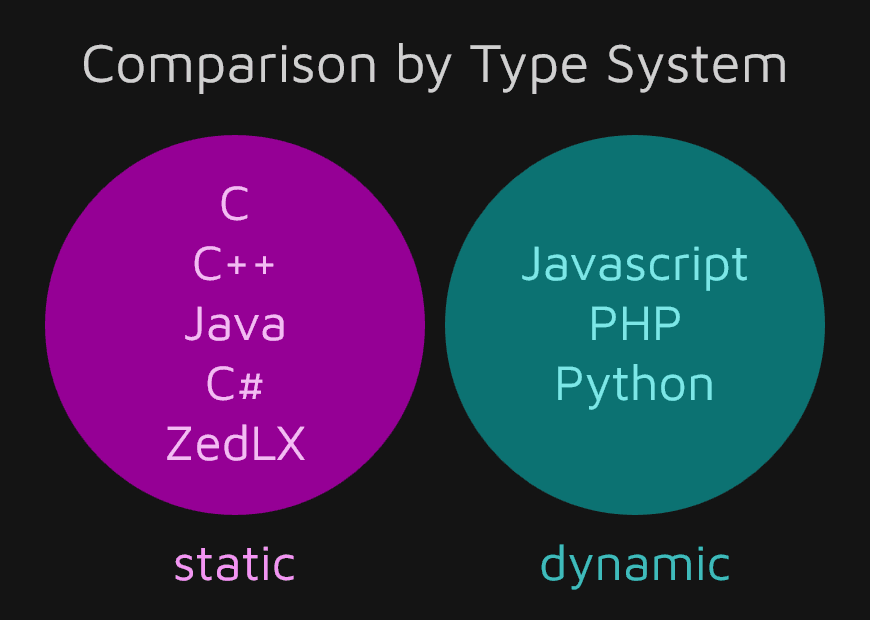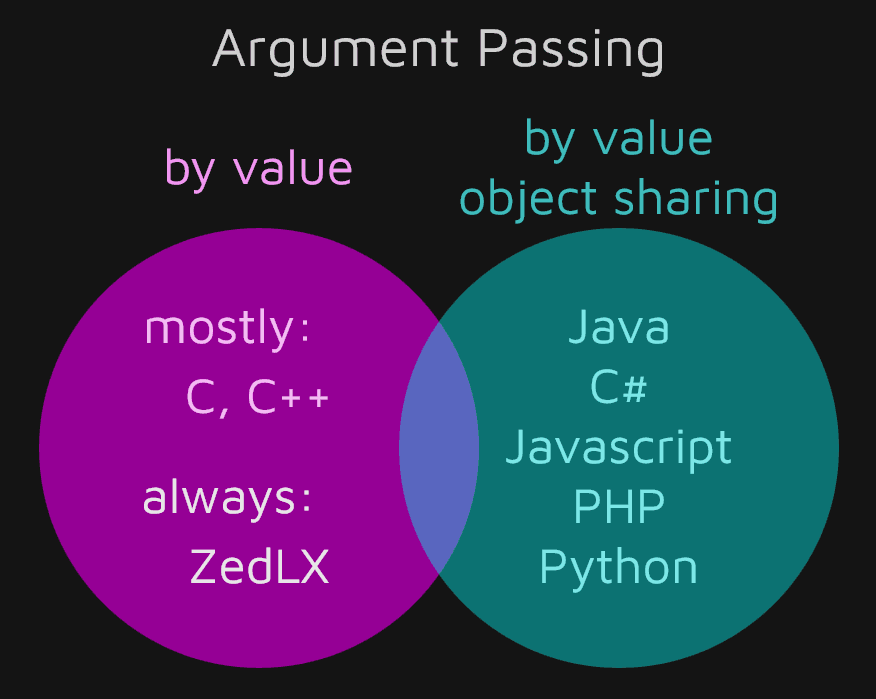A Quick Comparison of Programming Languages [1/10]
A Quick Comparison of Programming Languages
A common dilemma among programming beginners is choosing the first programming language to learn. Contrary to popular belief, this initial choice is not as critical as often perceived.
Since most popular programming languages share similar features, once the basics of programming are learned in one language, it becomes relatively easy to switch to another one.
A high-quality programming tutorial can make learning much easier, so finding a good tutorial is crucial. With a good tutorial, learning is much faster, regardless of the language.
The ZedLX tutorial is designed for young adults, incorporating computer graphics from the start and providing an intuitive learning environment.
2. Comparison by Syntax
Let's compare popular programming languages like C, C++, Java, C#, Javascript, PHP, and Python to ZedLX.
Notably, ZedLX is the only language on this list designed with beginners in mind.
To start, we can compare languages on a syntactic level, which defines how language constructs are written.
C-style syntax is widely used among languages and programmers, with C, C++, Java, C#, Javascript, and PHP all using a similar free-form syntax. ZedLX also uses a free-form syntax, but with some differences.
Python stands out as the only language on the list with a distinct syntax, which is not free-form.
While ZedLX shares similarities with C-style syntax, it also incorporates elements of Python-style syntax, making it a unique blend.

3. Similarity of Syntax
Since the syntax of most popular programming languages is relatively similar, developers can often switch between languages with minimal effort.
Syntax is also relatively easy to learn. Even an AI can easily adapt to a new syntax and explain why it's not a significant issue, as in this example
The real challenge lies in mastering the effective use of common programming language features, such as expressions, loops, variables, functions, and types.
Notably, languages like C, C++, Java, C#, Javascript, PHP, Python, and ZedLX share many fundamental features, with significant similarities even in their advanced features.
4. Level of Abstraction
The syntax of a programming language is a relatively minor concern.
More importantly, languages can be distinguished by their level of abstraction. The C programming language has a low level of abstraction, while C++ combines both low-level and high-level features.
In contrast, languages like Java, C#, Javascript, PHP, and Python are languages with a high level of abstraction.
ZedLX is also a high-level language, which is designed to offer an even higher level of abstraction. This reflects the philosophy that programming education should start with the highest possible level of abstraction.

5. Static vs Dynamic Type System
A key distinction among programming languages is their type system.
Some languages, such as C, C++, Java, and C#, use a static type system, while others, like Javascript, PHP, and Python, use a dynamic type system.
ZedLX has a static type system, which is especially useful for novice programmers, because it helps them to more easily find mistakes in their code.
[See the error by clicking the 'Check' button]

6. Argument Passing
Another important distinction among programming languages is the argument passing convention.
C and C++ use call-by-value, whereas Java, C#, Javascript, PHP, and Python use a mixed convention, passing primitive types by value and other types by object-sharing.
ZedLX uses call-by-value, making it more similar to C and C++. This approach is also more beginner-friendly than object-sharing.
Note that C and C++ have some additional complexities, but we'll keep the discussion simple for now.

7. Differences Between C and C++
The difference between C and C++ is often a topic of interest. C is an older language, and C++ can be seen as an extension of C, with many useful features added on top.
As a result, it's easy to write a C program that's also valid in C++. However, if you're writing a C++ program, it will likely no longer be compatible with C.
The added features in C++ make it a more expressive language, and most programmers appreciate the extra capabilities. Although C++ has a vast number of features, many of which are rarely used, they contribute to the language's expressiveness and make programming easier. In fact, C++ is often considered more accessible to beginners than C.
In contrast, C is a compact language that can be difficult for beginners to learn. Despite its small size, C lacks many features that simplify programming, making it more challenging to master. Moreover, even knowing the entire C language does not necessarily guarantee that someone is be a good programmer.
8. Learning Computer Programming
Learning computer programming is distinct from learning a specific programming language. While being proficient in a language is useful, it's secondary to the more important aspect of programming: learning to effectively use language features to turn your ideas into working programs.
Mastering programming involves understanding how to use language elements to create functional, efficient, and well-structured programs.
Learning computer programming is a long-term endeavor. As you continue to learn, you'll be able to create more complex and effective programs, and your skills and abilities as a programmer will continue to improve.
ZedLX is a programming language specifically designed for kids and beginners,
making it an ideal tool for learning computer programming.
With its interactive and colorful graphics,
ZedLX provides a engaging and immersive learning experience.
[Run the program by clicking on the 'Run' button]
ZedLX features a simple, clean, and beginner-friendly syntax, as well as error messages and a type system designed with beginners in mind. These features, among others, make it easy for kids and adults to learn programming concepts. A person who has mastered ZedLX will find it easy to transition to other programming languages, such as C, C++, Java, or Python.
One notable feature of ZedLX is its built-in computer graphics functions, which set it apart from other languages. Unlike other languages, which require additional libraries and complex initialization procedures, ZedLX allows users to create interactive graphics from the start. This built-in functionality is not only fun, but also serves as a valuable visualization aid for understanding more complex programming concepts.
By incorporating computer graphics, ZedLX makes learning more engaging and interactive. It eliminates the need for tedious text-based lessons, making the learning process more enjoyable and effective. With ZedLX, kids can start creating interactive graphics from their very first lesson, making programming a fun and exciting experience. As a result, kids love using ZedLX to learn programming, and it has become a popular choice for introductory programming courses.
10. Other Differences
This chapter has covered the most significant differences between programming languages, but there are many more nuances to explore. However, the key takeaway is that you can start learning programming with any of the mentioned languages.
For beginners, ZedLX is likely the easiest language to learn, providing a gentle introduction to programming concepts. Its design and features make it an ideal starting point for those new to programming.
To continue your learning journey, click on the 'Articles' button to explore more topics. You can also visit ou 'Gallery' to discover a wide range of programs, and check out the 'Overview' of our main programming tutorial for beginners.
We hope you have fun learning and experimenting with programming!
<< F2:Prev - - F4:Next >>